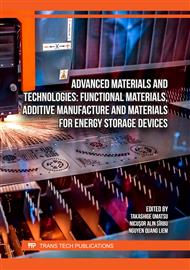p.3
p.9
p.17
p.23
p.31
p.39
p.45
p.51
Quasi Solid Polyzwitterion- Polyacrylamide Electrolytes for Rechargeable Zinc-Ion Battery
Abstract:
Zinc-ion batteries have attracted significant attention due to their low cost, rechargeability, and superior safety features. In fact, the use of aqueous electrolytes negatively affects battery performance due to the solid electrolyte interface (SEI), creating zinc corrosion, hydrogen evolution reaction (HER), and dendrite formation. To address these challenges, quasi-solid electrolytes (QSE) based on polyacrylamide-poly (3-(1-vinyl-3-imidazolio) propanesulfonate) (PAM/PVIPS) have been developed. PAM stands out as matrix QSE due to its excellent flexibility and electrochemical stability. PVIPS offers a well-defined pathway for ion transportation caused by cationic and anionic groups in structure. Clearly, the asymmetrical zinc cell with PAM/PVIPS QSE effectively reduces the overpotential profile, prolongs the stabilized zinc plating/stripping and enhances ionic conductivity, compared to PAM QSE. Additionality, the performance of Zn||δ-MnO2 is also enhanced with PAM/PVIPS QSE, yielding the specific capacity value of 65 mAh g-1, which is superior to the pristine PAM QSE (56 mAh g-1).
Info:
Periodical:
Pages:
17-22
Citation:
Online since:
October 2024
Price:
Сopyright:
© 2024 Trans Tech Publications Ltd. All Rights Reserved
Share:
Citation:



